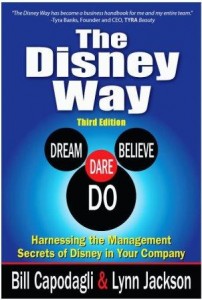A dream is a wish your heart makes. -Jiminy Cricket
It is no easy matter to convey a dream. Dreams are, by nature, deeply personal experiences. But true to his imaginative genius, Walt Disney was able to transform his dreams into stories that effectively articulated his vision to others. More importantly, the stories served to draw others into his fantasies, thereby marshaling the power of their collective creativity for the benefit of his dream. – The Disney Way, 3E: Harnessing the Management Secrets of Disney in Your Company.
 Starting a project “The Disney Way” may seem similar to how we think about most projects. Create the vision, mission, identify outcomes (objectives), scope, and architecture. The difference is in the picture you paint. You start packaging the Dream as a story from the very beginning. You are not waiting for the story to unfold, but you are creating the dream in a very factual way. You are building characters, personas in business terms, that come to life with the problems and gains that they want to receive. We make them real and create the journey. the story of the path to make them attainable.
Starting a project “The Disney Way” may seem similar to how we think about most projects. Create the vision, mission, identify outcomes (objectives), scope, and architecture. The difference is in the picture you paint. You start packaging the Dream as a story from the very beginning. You are not waiting for the story to unfold, but you are creating the dream in a very factual way. You are building characters, personas in business terms, that come to life with the problems and gains that they want to receive. We make them real and create the journey. the story of the path to make them attainable.
In many of our products/services we develop around and idea versus a dream. The idea will create something and most of the time something of value. I contrast this difference often in Lean terms; we make something faster, better and cheaper than the other product/services out there. We might even have a defined niche, a target market that we have defined. However, our customers find the product uninspiring. They rather just continue doing the same old thing of slower, not quite as good and maybe, more costly.
Why is that? Well, we all know just the functional aspects are not the only thing we must consider. We know we need to find the emotional connection; purchases are driven by emotion. Or, at least social, maybe we need stronger influencers?
The Disney Way does not dispute those facts but at the Dream Stage, it inspires people from the very beginning. It creates the story with a cast of characters that support and become engulfed in the outcome. I like to think about what Steve Jobs said about the competition, Microsoft, when they were developing the Zune. He said, “Our people like music.” Which was not a reflection on Microsoft but a reflection that at Apple the people were inspired by being part of the story, part of the dream.
When the Dream stage at your company is created, it should move your product/service to a higher level. It should inspire all the characters to visualize the world that has not been created yet. I cannot think of better words than how Bobby Kennedy said it, “There are those who look at things the way they are, and ask why… I dream of things that never were, and ask why not?”
The Dream stage is not something that we create that is not attainable. If you are a Lean person, Toyota Kata follows a very similar path. Think of the dream as the vision, the challenge. But phrase that challenge in a story that talks to real people with outcomes that will inspire them. Not all of us may have a product/service that can put thousands of songs in our pockets. However, all of us can and should dream and make those wishes from our heart.
Walt Disney’s original success formula, “Dream, Believe, Dare, Do”, can transform both entrepreneurial and Fortune 500 companies alike. Bill Capodagli is the co-author of The Disney Way, 3E, along with several other books (I have them all), and can be found at Capodagli Jackson Consulting.
This is a first of a series of posts this week on the Four Stages of The Disney Way: Dream, Believe, Dare, Do.

